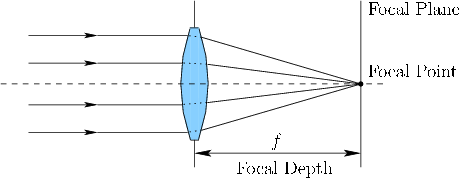
Next: Simple convex lens Up: 4.2 Lenses Previous: Snell's Law Contents Index
Imagine shining a laser beam through a prism, as shown in Figure 4.10. Snell's Law can be applied to calculate how the light ray bends after it enters and exits the prism. Note that for the upright prism, a ray pointing slightly upward becomes bent downward. Recall that a larger refractive index inside the prism would cause greater bending. By placing the prism upside down, rays pointing slightly downward are bent upward. Once the refractive index is fixed, the bending depends only on the angles at which the rays enter and exit the surface, rather than on the thickness of the prism. To construct a lens, we will exploit this principle and construct a kind of curved version of Figure 4.10.
 |
Steven M LaValle 2020-11-11